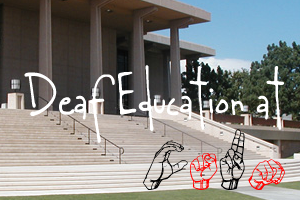Planning your Induction Program
(Level II- Professional Clear Credential)
DHH Level II Standards | Part A Induction Plan (pdf) | Part B Individual Goals (.doc) | Special Populations Options |
Deaf Community Log (pdf) | DHH Portfolio Rubric (.doc) | Standard 19- EL Authorization
Professional Clear (Level II) Credential
Level II Education Specialist Credential- Deaf/Hard of Hearing
After you have been issued a Preliminary Level I Education Specialist Credential and you have a job teaching DHH students, you are ready for the Level II program. The Level I credential is valid for five years from the date of issuance. The date of issuance is the date your employer indicated was your initial date of employment in the specialist position.
During the term of this credential you must complete the requirements for the Professional Clear Level II Credential. These requirements are listed on your credential and explained below.
Out of state applicants may have additional requirements.
For more information, please consult the California Commission on Teacher Credentialing Education Specialist Leaflet.
Applicants must satisfy all of the following requirements:
1 . Complete an Individualized Induction Plan designed in collaboration with your employer and a California college or university with a Commission-accredited education specialist program in the area of specialization listed on the preliminary level I credential (This plan will include academic requirements applicable to all Level II candidates as well as individualized studies and consultations specific to your assignment. This plan may contain up to 25 percent nonuniversity-based activities, if approved by the college or university administering the program.)
2 . Health Education – complete a unit requirement in health education, including, but not limited to, nutrition; the physiological and sociological effects of abuse of alcohol, narcotics, and drug abuse, and the use of tobacco (This requirement must include verification of training in cardiopulmonary resuscitation (CPR) that covers infant, child, and adult CPR skills. CPR certification must be completed while enrolled in a teacher preparation program or while teaching on a valid credential based on a teacher
education program.)
3 . Computer Education – complete a computer education course, which includes general and specialized skills in the use of computers in educational settings.
4. Complete of a minimum of two years of successful experience in your credential specialization in a public school (or private school with equivalent status) while holding the Preliminary Level I Education Specialist Instruction Credential, verified by your employer .
5 . Obtain a formal recommendation for the credential by the college or university through which your induction plan was completed.
DHH standards and the Level II Program at CSUN
*Please obtain ADVISING from Faculty in Deaf Education PRIOR TO ENROLLING IN COURSEWORK
This list does not serve as a Program Plan and does not include additional credential requirements.
California Commission on Teacher Credentialing
Induction Coursework: SPED 628D / SPED 629D: Level II candidates in SPED 628D & SPED 629D (and SPED 506D 3rd & 4th semester Interns) will demonstrate knowledge, skills, and professional dispositions related to standards from the California Commission on Teacher Credentialing (CTC) Standards of Quality and Effectiveness for Education Specialist Credential Programs: Deaf/Hard of Hearing Special Education Teaching Credential.
Standard 13: Advancement of Personal Communication Skills
Each Level II candidate demonstrates advanced personal communication skills which are necessary to effectively interact with the deaf and hard-of-hearing students with whom they work. Each candidate demonstrates an advanced level of communication skills, compared with that required in Level I.
Passage of the ASLPI at Level II: 3.0 overall/ 3.5 comprehension
Standard 14: Special Populations within the Deaf and Hard-of-Hearing Community
Each Level II candidate demonstrates advanced knowledge and skills related to effective assessment and instruction of deaf and hard-of-hearing students with special needs.
These are potential courses within the Department of Special Education that may fulfill the Special Populations requirement. For more information, consult the university catalog and/or the individual instructor, as well as your Advisor in DHH.
SPED 505MM CURR AND INSTR FOR DIV LRNRS WITH M/M DIS (3)
SPED 581 AUGMENTATIVE AND ALTERNATIVE COMMUNICATION (3)
SPED 624 ENGLISH LEARNERS WITH DISABILITIES (3)
SPED 640 PHYSICAL AND MULTIPLE DISABILITIES (3)
SPED 642 STUDENTS WITH MULTIPLE AND SENSORY IMPAIRMENTS (3)
SPED 652 EDUC CHILDREN WITH MOD & SERIOUS EMOTIONAL DIS (3)
SPED 655 THEOR & EMPIRICAL BASES OF EDUC OF LNRS W/ AUTISM (3)
Standard 15: Early Childhood Intervention and Education
Each Level II candidate demonstrates knowledge of and ability to assess deaf and hard-of-hearing infants and to plan, coordinate, collaborate, and/or implement an appropriate program for infants and their families.
SPED 695D: Working with Very Young DHH Children and their Families (3)
Spring Semester; Partially online (hybrid)Standard 16: Involvement with the Deaf Community
Each Level II candidate utilizes interaction opportunities with deaf and hard-of-hearing adults.
Involvement with the Deaf Community Description (PDF)
Standard 19: English Learner Standard (EL Authorization)
SPED 624: English Learners with Disabilities (3)
